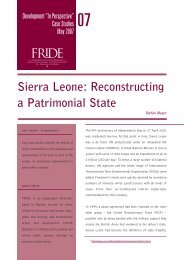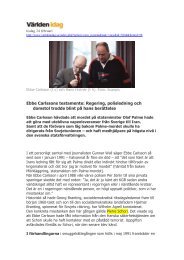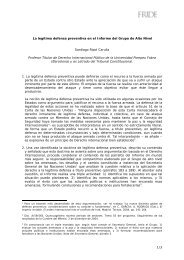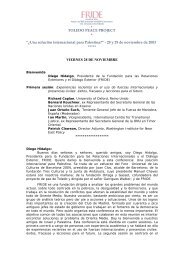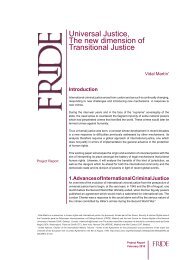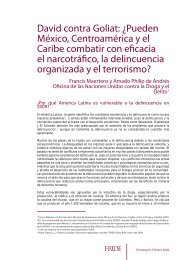Quick Fix or Quicksand? Implementing the EU Sahel Strategy - FRIDE
Quick Fix or Quicksand? Implementing the EU Sahel Strategy - FRIDE
Quick Fix or Quicksand? Implementing the EU Sahel Strategy - FRIDE
Create successful ePaper yourself
Turn your PDF publications into a flip-book with our unique Google optimized e-Paper software.
2<br />
WORKING PAPER 114<br />
I. The <strong>EU</strong> approach: integrating<br />
development and security<br />
The <strong>Sahel</strong> <strong>Strategy</strong> argues that allied terr<strong>or</strong>ist and criminal groups in <strong>the</strong> <strong>Sahel</strong><br />
represent immediate and longer-term risks to European interests because of<br />
<strong>the</strong>ir growing ability to take advantage of weak state presence and o<strong>the</strong>r prevailing<br />
conditions in <strong>the</strong> region, including ‘extreme poverty… frequent food crises, rapid<br />
population growth, fragile governance, c<strong>or</strong>ruption [and] unresolved internal tensions’. 6<br />
To address <strong>the</strong>se challenges, it advocates policy interventions that better integrate<br />
<strong>the</strong> development and security dimensions of <strong>EU</strong> policies. In March 2011, <strong>the</strong> <strong>EU</strong><br />
F<strong>or</strong>eign Affairs Council adopted <strong>the</strong> <strong>Sahel</strong> <strong>Strategy</strong> and welcomed <strong>the</strong> identification<br />
of three ‘c<strong>or</strong>e’ countries – Mali, Mauritania and Niger – as its primary focus. 7 AQIM’s<br />
recent consolidation in n<strong>or</strong><strong>the</strong>rn Mali is pushing <strong>the</strong> <strong>EU</strong> to pay closer attention to this<br />
evolving security threat alongside <strong>the</strong> longer-standing governance and development<br />
challenges in <strong>the</strong> <strong>Sahel</strong>, and engage through its Common Security and Defence Policy<br />
(CSDP).<br />
One year into <strong>the</strong> implementation of <strong>the</strong> <strong>Sahel</strong> <strong>Strategy</strong> and amidst a deteri<strong>or</strong>ating<br />
security and humanitarian outlook in <strong>the</strong> <strong>Sahel</strong>, <strong>the</strong> F<strong>or</strong>eign Affairs Council meeting of<br />
23 March 2012 restated <strong>the</strong> Council’s commitment to helping address <strong>the</strong> challenges<br />
facing <strong>the</strong> region. From <strong>the</strong> outset, <strong>the</strong> strategy relied on a po<strong>or</strong>ly defined geographic<br />
framing that barely reflects <strong>the</strong> complex interactions among interlinked conflict systems<br />
spanning <strong>the</strong> <strong>Sahel</strong>. As one commentat<strong>or</strong> notes, ‘<strong>the</strong> <strong>EU</strong> tends to consider <strong>the</strong> <strong>Sahel</strong> as<br />
an issue with a vertical <strong>or</strong>ientation from N<strong>or</strong>th to South. Indeed, one can stretch <strong>the</strong><br />
region from N<strong>or</strong><strong>the</strong>rn Niger to Nigeria [through] Chad’. 8 In addition, development<br />
instruments have been disprop<strong>or</strong>tionately emphasised in <strong>the</strong> <strong>EU</strong>’s implementation<br />
eff<strong>or</strong>ts to <strong>the</strong> detriment of m<strong>or</strong>e security-based responses adapted to <strong>the</strong> mounting<br />
insecurity in <strong>the</strong> region.<br />
The drivers of recent changes in <strong>the</strong> <strong>Sahel</strong> are manifold. Libya’s regional role has been<br />
transf<strong>or</strong>med post-Muammar Gaddafi; Nigeria’s Boko Haram (BH) is now a maj<strong>or</strong><br />
player in <strong>Sahel</strong>ian insecurity, whilst Algeria is staunchly opposed to <strong>EU</strong> security<br />
involvement in <strong>the</strong> area. Europe’s regional engagement has also been selective: regional<br />
bodies such as <strong>the</strong> Economic Community of West African States (ECOWAS) and <strong>the</strong><br />
African Union (AU) have only been gradually drawn into implementation eff<strong>or</strong>ts.<br />
At <strong>the</strong> same time, Mali’s destabilisation and <strong>the</strong> establishment of Islamist rule in its<br />
n<strong>or</strong><strong>the</strong>rn territ<strong>or</strong>ies undercut <strong>the</strong> <strong>EU</strong>’s hope that democratic stability will undergird<br />
partnership with fragile <strong>Sahel</strong>ian states. The increasingly fluid regional environment,<br />
in which both state auth<strong>or</strong>ity and regional cooperation have been weakened, challenges<br />
6. <strong>Sahel</strong> <strong>Strategy</strong>, op. cit., p.2.<br />
7. Council Conclusions on an <strong>EU</strong> <strong>Strategy</strong> f<strong>or</strong> Security and Development in <strong>the</strong> <strong>Sahel</strong>, 21 March 2011, para. 3.<br />
8. Bérangère Rouppert, ‘The European <strong>Strategy</strong> f<strong>or</strong> Development and Security in <strong>the</strong> <strong>Sahel</strong>: Rupture <strong>or</strong> Continuity?’, Switzerland: GRIP, 16 January<br />
2012, p.12.



